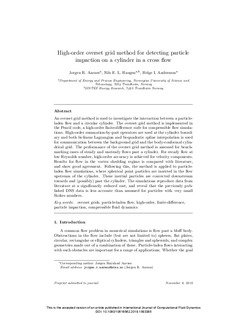| dc.contributor.author | Aarnes, Jørgen Røysland | |
| dc.contributor.author | Haugen, Nils Erland L | |
| dc.contributor.author | Andersson, Helge Ingolf | |
| dc.date.accessioned | 2019-11-21T14:17:29Z | |
| dc.date.available | 2019-11-21T14:17:29Z | |
| dc.date.created | 2019-04-08T13:12:43Z | |
| dc.date.issued | 2019 | |
| dc.identifier.citation | International journal of computational fluid dynamics (Print). 2019, 33 (1-2), 43-58. | nb_NO |
| dc.identifier.issn | 1061-8562 | |
| dc.identifier.uri | http://hdl.handle.net/11250/2629880 | |
| dc.description.abstract | An overset grid method was developed to investigate the interaction between a particle-laden flow and a circular cylinder. The method is implemented in the Pencil Code, a high-order finite-difference code for compressible flow simulation. High-order summation-by-parts operators were used at the cylinder boundary, and both bi-linear Lagrangian and bi-quadratic spline interpolation were used to communicate between the Cartesian background grid and the body-conformal cylindrical grid. The performance of the overset grid method was assessed to benchmark cases of steady and unsteady flows past a cylinder. Results show high-order accuracy and good agreement to the literature. Particle-laden flow simulations were performed, with inertial point particles impacting on a cylinder. The simulations reproduced results from the literature at a significantly reduced cost. Further, an investigation into blockage effects on particle impaction revealing that the previously published DNS data is less accurate than assumed for particles with very small Stokes numbers. © 2019, © 2019 Informa UK Limited, trading as Taylor & Francis Group. | nb_NO |
| dc.language.iso | eng | nb_NO |
| dc.publisher | Taylor & Francis | nb_NO |
| dc.title | High-order overset grid method for detecting particle impaction on a cylinder in a cross flow | nb_NO |
| dc.type | Journal article | nb_NO |
| dc.type | Peer reviewed | nb_NO |
| dc.description.version | acceptedVersion | nb_NO |
| dc.source.pagenumber | 43-58 | nb_NO |
| dc.source.volume | 33 | nb_NO |
| dc.source.journal | International journal of computational fluid dynamics (Print) | nb_NO |
| dc.source.issue | 1-2 | nb_NO |
| dc.identifier.doi | 10.1080/10618562.2019.1593385 | |
| dc.identifier.cristin | 1690842 | |
| dc.relation.project | Norges forskningsråd: 231444 | nb_NO |
| dc.relation.project | Norges forskningsråd: 267957 | nb_NO |
| dc.relation.project | Notur/NorStore: NN9405K | nb_NO |
| dc.relation.project | Notur/NorStore: NN2649K | nb_NO |
| dc.description.localcode | Locked until 22.3.2020 due to copyright restrictions. This is an [Accepted Manuscript] of an article published by Taylor & Francis in [International journal of computational fluid dynamics] on [22 Mar 2019], available at https://doi.org/10.1080/10618562.2019.1593385 | nb_NO |
| cristin.unitcode | 194,64,25,0 | |
| cristin.unitname | Institutt for energi- og prosessteknikk | |
| cristin.ispublished | true | |
| cristin.fulltext | postprint | |
| cristin.qualitycode | 1 | |
